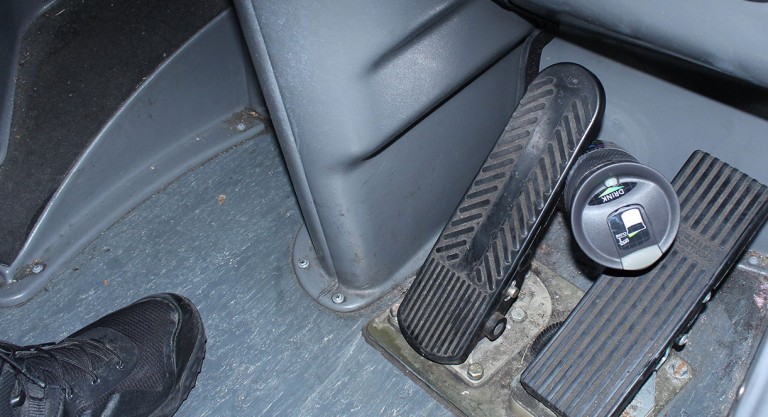Photo Courtesy of NTSB
NTSB investigators re-enact a possible scenario in which a dropped Thermos bottle causes runaway acceleration and prevents braking.
By Michael V. Cusenza
A dropped Thermos bottle lodged between the brake and accelerator pedals could not be ruled out as a possible cause for the fatal 2017 collision between two buses in downtown Flushing, according to the National Transportation Safety Board’s report issued Thursday.
In September 2017, three people were killed and another 17 injured after a tour bus barreled into a Metropolitan Transportation Authority bus at a high rate of speed at the intersection of Northern Boulevard and Main Street. Raymond Mong, 49, was behind the wheel of the Dahlia Group Inc. charter when it plowed into the rear of the Q20 at approximately 60 miles per hour. Mong and two pedestrians died.
According to the NTSAB, its investigators used data from telematic systems on the motorcoach and the transit bus and security video footage to establish the timeline of events, including respective vehicle location tracking, lane positions, and pre-crash speeds. The investigation was aided by a GPS device on the motorcoach which provided video and audio from its forward facing camera, the NTSB report noted.
Investigators found no evidence that Mong’s experience, training, route familiarity or pre-crash activities were factors in the collision. The GPS recording indicates that Mong was conscious and aware of the hazardous conditions preceding the crash but was unable to control the vehicle’s speed. Security camera video of the crash shows no illumination of the motorcoach brake lights before impact, but no mechanical or operational issues were found with the motorcoach. NTSB investigators ruled out a deliberate intent by the driver to crash his vehicle.
Investigators then considered the possibility that an object became lodged beneath or between both the brake and the accelerator pedals, resulting in uncontrolled acceleration and the inability to apply the brakes. At the scene of the crash, investigators found a metal Thermos bottle near the control pedals. The Thermos could potentially explain the metal rattling heard on the audio recording. Mong’s wife said he had taken his Thermos for the trip.
Board officials examined the audio to determine if a dropped Thermos could have created the sound, but the results were inconclusive. Metallurgists from the NTSB Office of Research and Engineering examined marks on the Thermos to determine if they could have been caused by contact with the vehicle control pedals, but no physical evidence was found. Investigators also obtained a similar Thermos and attempted to lodge it in the pedals of an exemplar motorcoach. They found that it was possible to position the Thermos beneath and between the pedal controls such that it prevented brake application while depressing the throttle.
The NTSB concluded that though an obstructed brake pedal could not be discounted as a factor in the crash, it also could not be determined as causal to the crash. The NTSB’s official finding of probable cause was “the driver’s unintended acceleration of the motorcoach and inability to brake for reasons that could not be conclusively determined from the information available.”

